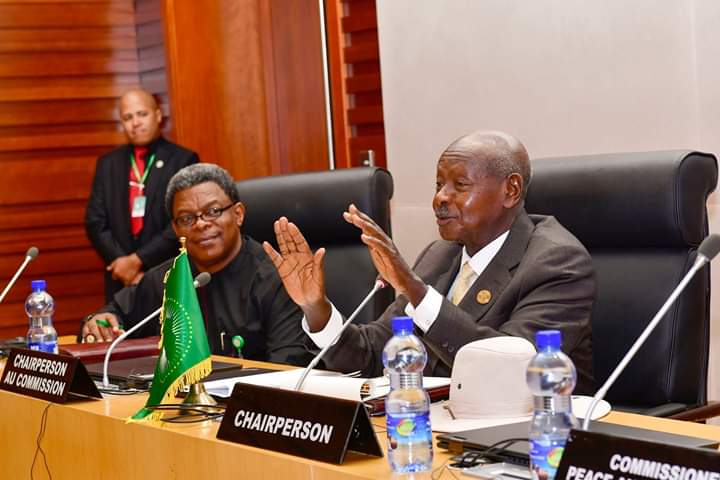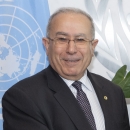
Monday 10 February 2020, Addis Ababa, Ethiopia:
African Union Summit
Particularly since 2004, with the operationalization of the AU Peace and Security Council, the noble objective of silencing the guns and ending wars in the continent is achievable”, said Amb. Ramtane Lamamra, Special Envoy of the AUC Chairperson, H.E Moussa Faki Mahamat, on Silencing the Guns.
He was speaking Sunday 9 February 2020, at the AU Headquarters in Addis Ababa, Ethiopia, while addressing the 33rd Ordinary Session of the Assembly of the African Union on the implementation of the flagship project on silencing the guns within the context of the African Union (AU) theme for 2020, in the presence of the newly elected Chair of the Union Cyril Ramaphosa, President of the Republic of South Africa.
Realising a conflict-free Africa is the dream of every African. In this edition, we highlight the current hotspots; the root causes of conflicts; the various efforts in search of peaceful co-existence and development and the African Union’s quest for silencing the guns by 2020.
In 2013 African Union (AU) member state representatives gathered at its headquarters in Addis Ababa, Ethiopia, where the Organisation of African Unity was established in 1963, to celebrate the body’s 50th anniversary.
Amid the pomp and ceremony, the leaders sat down to reflect and tackle the tough questions: What progress have we made towards the achieving of the objectives set by the AU and looking forward, what is our proposed vision for Africa for the next 50 years? Furthermore, what is the biggest challenge to realizing the aspirations of our people?
Nkosazana Dlamini-Zuma, then African Union Commission chairperson, had visited various countries collecting views from governments, civil society and the diaspora, on what they felt was the most pressing issue facing Africa, one the AU should deal with.
Most agreed that conflict remains one of the biggest challenges facing Africa. The AU also sees conflict as one of the biggest impediments to the implementation of Agenda 2063. Of course, there were other challenges facing the continent, including poverty, inequality, unemployment, climate change, illegal financial flows, corruption, etc, yet conflict tops the list.
“Before leaving Addis Ababa, the AU leaders resolved not to pass the burden of conflict to future generations, so they adopted “Silencing the Guns in Africa by 2020” as one of the flagship projects of the wider developmental blueprint Agenda 2063,” Ms. Aïssatou Hayatou, the AU “Silencing the Guns” operations manager, told Africa Renewal.
She added: “The objective was to achieve peace to allow for development across Africa.”

Notable progress has been made in preventing, managing and resolving conflicts in Africa but a number of African countries still remain trapped in a vicious cycle of violent conflict and its deadly consequences.Mr. Ramtane LamamraThe African Union’s High Representative for “Silencing the Guns” in Africa
The initiative was intended to achieve a conflict-free Africa, prevent genocide, make peace a reality for all and rid the continent of wars, violent conflicts, human rights violations, and humanitarian disasters. The leaders hoped to have all the guns silenced by 2020.
Since 2014, Africa has made progress in the quest for peace and security, mostly by strengthening continental response frameworks and institutions, as well as by working with the UN and other organisations on the ground. These initiatives have borne fruit.
Over the past two decades, the guns have been silenced in previous hotspots such as Angola, Côte d’Ivoire, Liberia and Sierra Leone. Significant strides have been made in difficult cases such as Somalia and Sudan, according to the Addis Ababa-based Institute for Security Studies (ISS), and peace-building initiatives on the continent have also helped quell many potential flare-ups.
However, fighting is still observable in Libya, South Sudan, the Central African Republic (CAR), the eastern Democratic Republic of Congo, and the Lake Chad Basin, which includes Chad and parts of Nigeria, Niger and Cameroon. Violent extremism in the Sahel and parts of the Horn and eastern Africa is also a challenge.
There are also threats from terrorism and transnational crime on the continent. Communal conflicts between herders and farmers over water and pasture; violent urban crime and cultural practices such as cattle rustling, are also of concern because firearms have become the weapons of choice, replacing traditional and less deadly weapons.
A 2017 study by Oxfam, The Human Cost of Uncontrolled Arms in Africa, estimates that at least 500,000 people die every year and millions of others are displaced or abused as a result of armed violence and conflict.
80% of all small arms in Africa are in the hands of civilians, according to the Small Arms Survey (SAS), an independent Geneva-based research centre which generates evidence-based, impartial, and policy-relevant knowledge and analysis on small arms and armed violence issues for governments, policy-makers, researchers, and civil society.
Most of the weapons in Africa are imported. Official military expenditure in Africa stood at around $40.2 billion in 2018, with North Africa spending $22.2 billion and sub-Saharan Africa $18.8 billion, according to the ISS.
The top arms suppliers to Africa between 2014 and 2018 were Russia, China, Ukraine, Germany and France, and the largest recipients were Egypt, Algeria and Morocco, according to a study by the Stockholm International Peace Research Institute (SIPRI), an independent international institute dedicated to research into conflict, armaments, arms control and disarmament. The SIPRI Arms Transfers Database provides information on all international transfers of major arms (including sales, gifts and production under license) to states, international organizations and non-state groups.
Twenty-two African countries also manufacture various kinds of small arms and light weapons. Homemade artisanal weapons production is also prevalent on the continent, with those weapons reported to be fueling criminality in some countries.
While African countries can control the purchase of legal arms, it is difficult to track the illegal trafficking and flows on the continent. Porous borders and long coastlines also enable traffickers to smuggle small arms between countries. There are also concerns about how well national arms stocks are managed to ensure that the weapons do not end up in the wrong hands.
“Guns are the most popular weapon on the continent. They cause more deaths than bombs, grenades or mines. The AK-47 remains the most dangerous killing tool in Africa currently,” says Ms. Hayatou, adding that a sizable chunk of the legally imported weapons in Africa are diverted illegally due to corruption.
Oftentimes government stocks are raided, or military troops or police officers are killed for their weapons. Of concern too are the substantial number of weapons coming out of Libya that were previously owned by the Muammar Gaddafi regime and that have now ended up in the Sahel. Many of these weapons are in the hands of separatist rebels in northern Mali.
To accelerate action, the AU is launching in early 2020 a continent-wide campaign on “Silencing the Guns” to mobilise all stakeholders to prioritize efforts on peace and effective socio-economic development. Challenges that lead people to violent conflicts, including poverty, historical injustices, inequality, unemployment, climate change, illegal financial flows, and corruption should be addressed too for the guns to be silenced.





